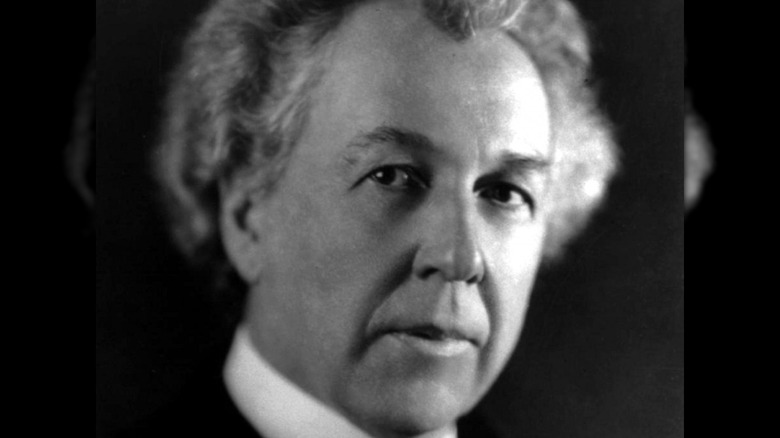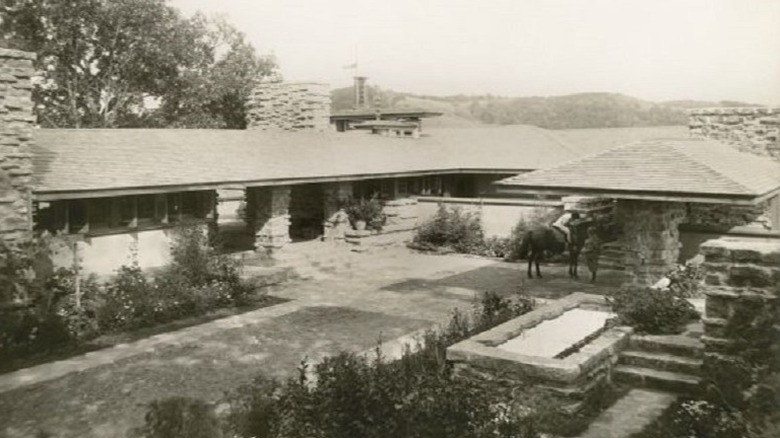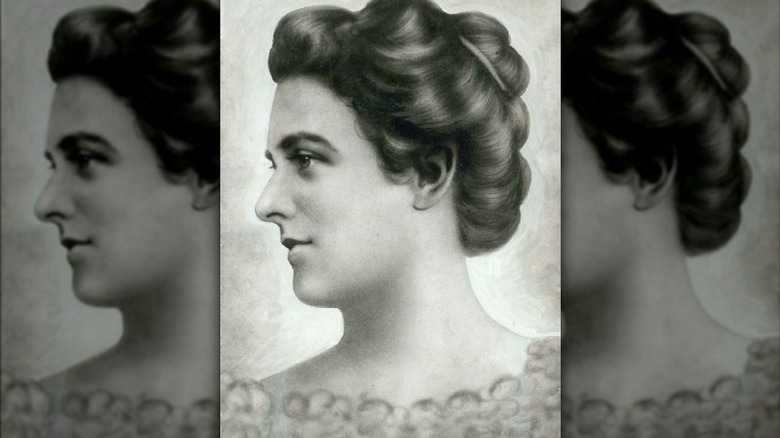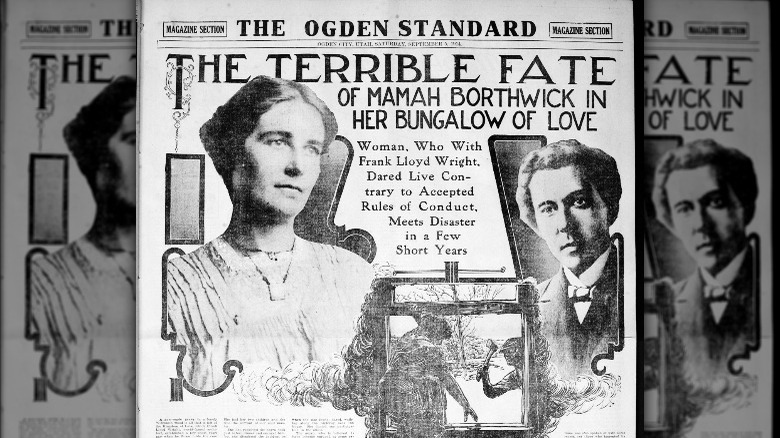The Massacre That Happened At Frank Lloyd Wright's Home In 1914
Frank Lloyd Wright is still considered one of the most famous architects in the world despite his death in 1959. He was known for designing what was called Prairie Style homes that he described as structures that linked "man, nature, and architecture." The architectural style, which became popular in the early 1900s, incorporated natural elements but also had a modern feel that emphasized building with planes horizontally instead of vertically. Wright used the style in many of his designs, and the homes stood out among the Victorian houses that were popular at the time. According to the Frank Lloyd Wright Foundation, the architect designed more than 1,100 structures in his career, and 532 of them were built. Among those, eight are included in UNESCO's World Heritage Site list.
When Wright's name is mentioned, his designs are what immediately come to mind. Not a lot of people know that the famous architect was connected to a massacre that took place in one of the houses he designed — his own, in fact. The structure, called Taliesin, still stands in Wisconsin to this day, and one would never think that the magnificent estate was once the scene of a brutal crime that took place in 1914.
The history of Taliesin
Frank Lloyd Wright married Catherine "Kitty" Tobin in 1889 and by 1903, the couple had six children together. At that time, the family lived in a Chicago suburb. It was then that Wright began an affair with Martha "Mamah" Borthwick, the wife of one of his clients. The affair carried on for years before the two decided to be with each other in 1909. Mamah left her husband and two children, and Frank left his six children and Kitty. According to Modernnati, the two eloped to Europe and the affair was the subject of countless newspaper articles. In their absence, Mamah's husband granted her a divorce, but Kitty refused to divorce the architect.
Frank and Mamah returned to the U.S. in 1910 and Frank decided that it was best not to return to Chicago, as the public still heavily talked about the scandalous affair (via Architectural Digest). He designed a house to be built on an expansive land in Wisconsin where he grew up and the house, which he called Taliesin, was finished in 1911. The sprawling estate was built to allow Mamah to live peacefully without disturbance from the public. Nancy Horan, the author of the book "Loving Frank," told NPR that the affair dampened Wright's career for a time, and Mamah's reputation was ruined, as she lived with a man who was still married. Despite shying away from the public eye, the architect and his mistress were still a hot topic for a while, and reporters dubbed the new house the "Love Cottage."
The day of the massacre
On August 15, 1914, Frank Lloyd Wright was away in Chicago for business. Mamah Borthwick was in Taliesin having lunch on the porch on a hot day with her two young children — 12-year-old John and 8-year-old Martha — who were staying with her for the summer. Also in Taliesin that day were six other people, five of them Wright's employees: draftsmen Emil Brodelle and Herbert Fritz, laborer Thomas Brunker, gardener David Lindblom, and foreman William Weston. Weston's son, 13-year-old Ernest, was also present (via The Lineup). They were enjoying their lunch in the house's main dining room. Throughout the summer, husband and wife Julian and Gertrude Carlton worked at Taliesin. Gertrude's main job was cooking for the household, while her husband did housework and repairs.
On that fateful day, Julian told his wife to go home after she finished cooking. When Gertrude left, Carlton attacked Mameh and her children with a hatchet. As reported by Crime Traveller, the men in the dining room weren't aware of the gruesome murders that occurred, as the house was so large that the screams were not heard. One of the men noticed the smell of gasoline, but before they could react, the room was already ablaze. Julian locked the door and the men scrambled to get out through a window, but Julian was positioned to attack with the hatchet. Three managed to escape: Lindblom, Fritz, and the elder Weston. However, Lindblom later died of the injuries he sustained. In total, seven people tragically lost their lives.
The suspected motive
Julian Carlton hid in a furnace and ingested hydrochloric acid in an attempt to take his own life. Authorities found him barely alive, and he was taken into custody, according to the Crime Museum. He never revealed his motive for the brutal murders. Just seven weeks after the massacre, Julian, who had a burned esophagus, died in jail due to starvation. Investigators interviewed Gertrude Carlton, but she insisted that she knew nothing about her husband's plans. However, she revealed what may have driven Julian to commit the horrible acts. In the days leading up to the massacre, Julian had become increasingly paranoid and started sleeping with a hatchet.
Some of the workers in the estate said that Julian often had disagreements with Mamah Borthwick and other employees. Another employee stated that the Carltons were being let go, and Gertrude confirmed it by revealing that she and Julian were scheduled to leave Taliesin on the night of August 15 to look for new employment in Chicago, as reported by History. Despite the suspicions, only Julian knew the real reasons for the murders, but he took that information with him to the grave. Gertrude was released from police custody after it was determined that she didn't know what Julian planned to do after he told her to leave the house.
The aftermath of the Taliesin massacre
Even in death, some reporters painted Mamah Borthwick in a bad light. The Ogden Standard wrote a headline that read, "Woman, who with Frank Lloyd Wright dared live contrary to accepted rules of conduct, meets disaster in a few short years" (via Newspapers). She was also mentioned in a San Francisco Examiner article titled "Pathetic Tragedies in American Social Life that Have Followed Defiance of the Moral Law." Frank Lloyd Wright wrote an open letter addressed to his neighbors and thanked them for their support during a difficult time. However, he also lambasted the media for reporting about the incident and adding details of their affair. Their story, he said was "falsified and vulgarized" and he defended Borthwick's honor, per PBS.
Wright ended the letter by saying that he will rebuild Taliesin, and that's what he did. However, the house burned down again in 1925 due to faulty electrical wiring. The house that stands on the estate today is the third version of Taliesin, and it became a UNESCO World Heritage Site in 2019 (via Taliesin Preservation). Wright buried Borthwick in a chapel near the house on his family's plot.




